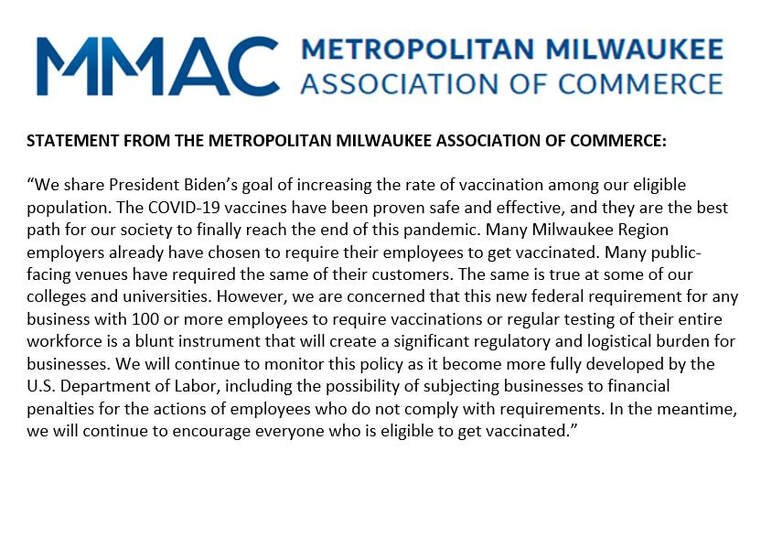 On Sept. 9, President Biden announced the Administration’s “Path Out of the Pandemic” plan. It may be weeks before our business community receives specific details from the federal government on the general policies that were announced. In many respects, there are more questions than answers. The following is an overview of what we know right now about the plan and how it may affect your business. We'd especially like to thank MMAC member Michael Best & Friedrich LLP for sharing their initial takeaways, many of which are incorporated here. Members also are welcome to attend MMAC’s Business of Metro MKE webinar on Tuesday, Sept. 14 from 11 a.m. to noon. In that program, experts from public health, human resources and law will discuss efforts to contain the spread of the Delta variant of COVID-19, what a return to the office looks like in this environment, and what we know about the new Biden administration plan. If you are already registered for the series, we’ll see you on Tuesday. If not, register for free on MMAC.org. Our perspective: MMAC shared the following statement Thursday evening: Our businesses, and you as business leaders, have already borne a significant and unprecedented burden during the COVID-19 pandemic. We remain committed to helping you, your companies and your employees navigate these obligations. Plan overview: Through a Department of Labor Occupational Safety and Health Administration (OSHA) Emergency Temporary Standard (ETS), employers with 100 or more employees must ensure their workforce is fully vaccinated or require any unvaccinated workers to produce weekly negative test results before coming to work. The Administration’s plan also includes the following obligations:
When will OSHA release its rule implementing the President’s requirements? And when will it go into effect? Currently, the plan does not estimate when it will be released or when it goes into effect, or how long employers will have to prepare. We hope that more guidance addressing employer concerns will be available in the coming days or weeks. Who will be responsible for payment of weekly testing of unvaccinated employees? The plan does not address who must pay for additional costs of testing unvaccinated employees on a weekly basis, including the time to get the negative test results. Who is responsible for the PTO the plan is requiring for employees who get vaccinated? The plan does not address who is financially responsible for the PTO, nor does it indicate whether the PTO requirement will be in addition to any employer-provided PTO benefit. Will the vaccination requirement apply to remote workers and remote employees? The plan lacks clarity whether remote workers will be required to get vaccinated, but the “before coming to work” language suggests that vaccination requirements may not apply to remote workers. Will the vaccination requirement apply to federal employees, and to contractors and subcontractors that do business with the federal government? The President has signed an Executive Order to require all federal executive branch workers to be vaccinated, “subject to exceptions required by law.” The President also signed an Executive Order directing that this standard be extended to employees of many contractors and subcontractors that do business with the federal government. These orders do not, as we read them, allow for employees to remain unvaccinated by providing a weekly negative test result. How will the vaccination requirement affect schools? The plan does not require teachers, staff, or students to be vaccinated. Nor does it require schools or school districts to adopt vaccination or testing requirements. However, the plan calls for governors to require vaccinations for teachers and school staff. Additionally, the plan calls for the Department of Education to make additional funding available to school districts for implementing COVID safety measures. Will existing mask rules stay in place? The plan calls for continued strong mask requirements to help slow and contain the spread of the virus and COVID-19 transmission keeping in place mask mandates at the federal level. President Biden’s executive order, “Promoting COVID-19 Safety in Domestic and International Travel,” directed applicable agencies to take action to require mask-wearing in airports and on certain modes of public transportation, including on many airplanes, trains, maritime vessels, and intercity bus services. TSA has extended its implementing orders for air and ground travel through Jan. 18, 2022, and the President’s plan will double fines for those who are not in compliance. The President’s plan will also ensure that masking requirements remain in place on the other modes of transportation as the country continues to battle COVID-19. Also, President Biden’s executive order, “Protecting the Federal Workforce and Requiring Mask-Wearing,” requires masks and specific physical distancing requirements in federal buildings, on federal lands, on military bases and other overseas locations consistent with CDC guidance. President Biden’s plan will ensure that these requirements remain in place as the nation continues to battle COVID-19. Again, thank you to Michael Best for sharing their perspective. Your partner in challenging times We will continue to share details on these new policies as they emerge. MMAC is here to help businesses and business leaders through this challenge and whatever comes next. If your business is already a member of MMAC, thank you for your investment. Our work would not be possible without you. If your company is not yet a member, our team would love the opportunity to speak with you. Comments are closed.
|
|
Copyright © 2024 Metropolitan Milwaukee Association of Commerce
All rights reserved. 301 W Wisconsin Ave., Ste. 220 | Milwaukee, WI 53203 Tel 414/287-4100 | Fax 414/271-7753 | [email protected] | Privacy Policy |
|

 RSS Feed
RSS Feed